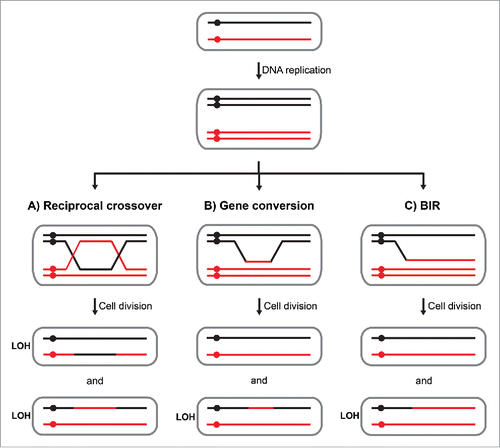Figures & data
Figure 1. Mechanisms and genetic outcomes of mitotic recombination. Black and red lines indicate 2 homologous chromosomes of a diploid cell and circles indicate centromeres. Upon DNA replication, chromosomes consist of 2 sister chromatids. (A) During a reciprocal crossover event, chromatid arms are exchanged between the homologs after a strand-specific cleavage of a double Holliday junction intermediate. If in the following division, recombinant molecules segregate to different cells, LOH occurs in both daughter cells. (B) A nonreciprocal transfer of genomic sequence between the homologues leads to a gene conversion event and LOH in one of the daughter cells. (C) Break-induced replication leads to a nonreciprocal transfer of genomic sequence extending until the end of a chromosome arm. LOH occurs in one of the 2 daughter cells.

Figure 2. Centromere-proximal bias of spontaneous LOH events in aging Drosophila ISCs. (A) Example of an aged female midgut heterozygous for an X-linked Notch mutation and a GAL80 transgene insertion proximal to the centromere. Dashed yellow lines indicate spontaneous LOH clones. Clonal loss of Notch is evident by accumulation of cells positive for Dl (cytosolic red in A, or cytosolic gray in A') or Prospero (nuclear red in A, or nuclear gray in A') markers. Loss of GAL80 activity is reflected by GFP expression (green in A, gray in A″). Shown are 3 clonal events: 2 with concomitant inactivation of GAL80 therefore expressing GFP, and 1 with only Notch LOH. Scale bar=50μm. (B-C) Schematic representations of somatic recombination events that could lead to identified clonal phenotypes in midguts with 2 different GAL80 insertion sites: distal (B) and proximal (C) to the centromere on the X chromosome. Yellow boxes represent regions of potential recombination initiation sites. For simplicity only the daughter cell in which LOH occurred is shown. Crossover-type events are represented, however BIR could also be involved. Fly crosses, aging and immunofluorescence were performed as previously described.Citation32

